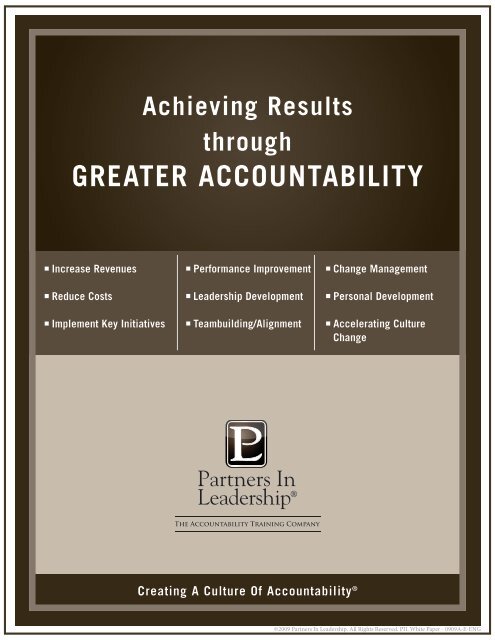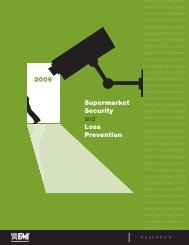GREATER ACCOUNTABILITY
GREATER ACCOUNTABILITY
GREATER ACCOUNTABILITY
Create successful ePaper yourself
Turn your PDF publications into a flip-book with our unique Google optimized e-Paper software.
Achieving Resultsthrough<strong>GREATER</strong> <strong>ACCOUNTABILITY</strong>• Increase Revenues• Reduce Costs• Implement Key Initiatives• Performance Improvement• Leadership Development• Teambuilding/Alignment• Change Management• Personal Development• Accelerating CultureChangeCreating A Culture Of Accountability ®©2009 Partners In Leadership. All Rights Reserved. PIL White Paper - 0909A-E-ENG
TABLE OF CONTENTSIntroduction: Creating A Culture Of Accountability ® ...........................1Premise: Accountability--A Flawed Definition ....................................2Accountability Begins: Clearly Defined Results ..................................3The Next Step: Alignment ...............................................................4Creating Accountability: Eliminating the Blame Game ........................5Sustaining Change ..........................................................................6Where to Go From Here ...................................................................7iCopyright ©2009 by Partners In Leadership. All rights reserved.No portion of these materials may be copied, reproduced, or distributed in any form, electronic or mechanical, including photo copy, recording, orby any other means, without the express, written permission of Partners In Leadership. The trademarks referenced herein as registered, are registeredin the U.S. and/or other countries.©2009 Partners In Leadership. All Rights Reserved.www.partnersinleadership.com | www.ozprinciple.com | Phone: 1-800-504-6070
INTRODUCTION: CREATING A CULTURE OF <strong>ACCOUNTABILITY</strong>®KEY SHIFTSCreating higher levels of accountability in business seemsto be a topic on every corporation’s agenda. Most companiescan draw a link between the results they are achieving and thelevel of accountability they see manifested throughout theirorganization. Knowing how to create and sustain a culture ofaccountability for most organizations is the greatest challenge.Companies that are operating with a high level of accountabilityare organizations that have been able to:Motivation For Outsourcing Training302010Accountability1.2.3.4.Clearly define their resultsCreate alignment around those resultsInstill accountability needed to deliver those resultsSustain change021% 1 2 3Diagram 1 - According to the 2005 ASTD State Of The IndustryReport, 21% of companies outsourcing training are doing so toincrease accountability. 1Organizations are able to do so by making several key shifts inthe way people think and act:How do successful organizations enable their people to takeownership for delivering on their intended results? Stayingcompetitive usually means finding practical answers to thatquestion. From our perspective, creating higher levels ofownership often drives better results and increases the valueand growth of the company. To be truly effective in today’scorporate environment, leaders must be able to help find waysto create higher levels of ownership and joint accountability forachieving key results.FromExternalizingBlaming OthersDoing The JobWorking In SilosTelling PeopleWhat To DoDiagram 2 - Key Shifts12005 ASTD State of the Industry ReportKey ShiftsToInternalizing The NeedFor ChangeTaking AccountabilityAchieving The ResultCollaboratingEngaging The HeartsAnd Minds Of PeopleExternalizing vs. Internalizing the Need for ChangePeople have a tendency to externalize the need for change. Mostpeople are quite skilled at recognizing there is a problem. Forexample, “I sure wish marketing would start doing their jobbetter” or, “I wish management would be more responsive.”People inherently struggle, however, with the ability to definethemselves within the problem. An accountable mindset is onethat says, “If I’m part of the problem, I’m part of the solution.”Blaming Others vs. Taking AccountabilityHuman nature drives people to blame others when things aregoing wrong. For some organizations, the Blame Game hasbecome so commonplace that it becomes not only accepted butexpected when someone doesn’t deliver. Organizations that areable to instill a Culture of Accountability are able to take all ofthe time, energy and resources employed in the Blame Gameand channel them into a consistent focus on the organizationalresults.Doing the Job vs. Achieving the ResultMost leaders are fairly capable when it comes to creatingaccountability for activity levels. Less common is a leader whohas created accountability around organizational results – a keyshift in Creating A Culture Of Accountability.Telling People What to Do vs. Engaging the Hearts and Minds ofPeopleThe “Tell Me What to Do” Culture is a culture where peoplecheck their brains at the door, punch the clock, and check offthe list of activities that define their job. This activity-orientedmentality tends to be devoid of pro-activity because, “No one istelling me what to do” A critical shift is engaging the hearts andminds of people instead of just their hands and feet.1©2009 Partners In Leadership. All Rights Reserved.www.partnersinleadership.com | www.ozprinciple.com | Phone: 1-800-504-6070
PREMISE: <strong>ACCOUNTABILITY</strong>--A FLAWED DEFINITIONTHE TRADITIONAL VIEWMost people view accountability as something that belittlesthem, happens only when performance wanes, or occurswhen problems develop or results fail to materialize. In fact,many think accountability only arises when something goeswrong or when someone else wants to isolate the cause ofthe problem--all for the sake of pinning blame and pointingthe finger.When the organizational ship is sailing along smoothlyand failure has not yet sunk the ship, people rarely ask,“Who is accountable for this success?” Only when the hullsprings a leak does anyone start looking around for theresponsible party. As a result, the notion of accountabilityfor many employees has taken on a hard, critical edge thatis often negative. The better question to ask is, “Who isaccountable?” before it’s too late. This needs to occur priorto deadlines, and in advance of the problems. By establishingaccountability up front, people are enlisted and empoweredto do all they can to ensure the desired result.Most dictionaries present a definition of accountability thatpromotes a seemingly negative view. Consider Webster’sdefinition:“Subject to having to report, explain orjustify; being answerable, responsible.” 2Notice how the definition begins with the words “subjectto,” implying little choice in the matter. This confessionorientedand powerless definition suggests what we all haveobserved--accountability is viewed as a consequence forpoor performance; it’s a principle you should fear because itwill only end up hurting you. Little wonder people spend somuch time avoiding accountability and trying to explain andThe Oz Principle ®AccountabilityQuestion“Who isaccountablefor achievingthe result?”the RESULTDiagram 3 - Accountability DefinitionThe TypicalAccountabilityQuestion“Who isaccountable forfailing to achievethe result?”justify poor results. A more positive and powerful definitionof accountability can do more to achieve outstanding resultsthan all the finger pointing and blaming that typicallyoccurs.In Diagram 3, the question on the right is really asking, “Whois to blame for this?” It is activity focused rather than resultfocused. When considering these two approaches, whichof these two approaches will have the greater impact onfostering and improving an organization’s ability to achieveresults--the ‘before-the-fact’ approach or the ‘after-thefact’way of establishing blame?THE ALTERNATIVE VIEWConsider the following alternative definition ofaccountability:“A personal choice to rise above one’scircumstances and demonstrate the ownershipnecessary for achieving desired results.”This definition suggests a mindset or attitude of continuallyasking, “What else can I do to rise above my circumstancesand achieve the desired results?” It involves a process ofseeing, owning, solving, and doing, and requires a level ofownership that includes making, keeping, and answeringpersonal commitments. Such a perspective embracesboth current and future efforts rather than reactive andhistorical explanations. Armed with this new definitionof accountability, organizations can help leaders andemployees do everything possible to both overcome difficultcircumstances and achieve desired results.22Webster’s Dictionary©2009 Partners In Leadership. All Rights Reserved.www.partnersinleadership.com | www.ozprinciple.com | Phone: 1-800-504-6070
<strong>ACCOUNTABILITY</strong> BEGINS: CLEARLY DEFINED RESULTSDOING THE JOB VS. ACHIEVING THE RESULTThe first step towards Creating A Culture Of Accountabilityis to define clear results within an organization. Nine outof ten companies have either not clearly defined resultsor have failed to communicate them broadly. It is virtuallyimpossible to create a culture of accountability if people areunclear about the key results they are expected to deliver.Whether the focal point is a sales goal, a specified deliveryperiod for a product, or a minimum return on investmentto achieve, people have to be clear on the direction. Once acompany-wide direction has been decided, accountabilityrequires that employees from the bottom to the top areclear on the results.Leaders will often say: “I don’t care how you do it, justget it done!” Many times, organizational charts and jobdescriptions push people into boxes. They give peoplethe idea that they are getting paid and using their skillsto perform a defined function or set of tasks. This taskorientedmindset leads people to believe that if they performtheir functions, they’ve done what they’re supposed to do,whether or not the desired result was achieved.Senior Management TeamsDon’t Clearly Define Results90%10%Diagram 4 - Nine out of ten senior management teams do not clearlydefine company resultsask, “What else can I do?” until the results are achieved.Rather than treating the circles in Diagram 5 as mutuallyexclusive, they lead their people to recognize their “job” asDoingThe JobDoingThe JobISAchieving TheResultAchievingThe ResultDiagram 5 - Doing the Job versus Achieving The ResultPeople are accountable for doing their job, but they’re notaccountable for delivering results.Creating accountability requires that doingthe job and delivering the result are one in thesame. Creating accountability means the job isnot done until the result is achieved.achieving the desired results. This mindset can become partof the culture only if people clearly understand the resultsthey are expected to deliver.Effective leaders operate on the premise that people aremore productive when they focus on achieving the result.They lead people beyond the boundaries of their jobs andinspire them to relentlessly pursue desired results bycreating an environment that motivates them to repeatedly3©2009 Partners In Leadership. All Rights Reserved.www.partnersinleadership.com | www.ozprinciple.com | Phone: 1-800-504-6070
THE NEXT STEP: ALIGNMENTCREATING ALIGNMENTWithout clarity, there can be no alignment. The targeted resultmust be clear to everyone on the team and then the results mustbe shared. Each team member must share accountability forachieving the result.Many management teams confuse agreement and alignment.Alignment means that a team may have some measure ofagreement but not necessarily total agreement. This meansthat a team can have some disagreement and still be aligned.In fact, an organization cannot have true alignment withoutdisagreement.True alignment does not occur until people have had theopportunity and assume the accountability to say what theyreally think in a manner that lets them work issues throughand gain some buy-in. Disagreement inevitably accompaniesthe process, and that can be good. People who entirely disagreewith a course of action will find it difficult to stay in alignmentfor long.Alignment does, however, bring agreement--the agreementto move forward, the agreement to support the directionor decision, and the agreement to speak up if you becomeunaligned. It is essential to work with people to develop somelevel of agreement about where the organization is headedand why.Unfortunately, a company’s culture does not maintainalignment by itself. Alignment is a process, not an event. It is aprocess because the forces working to push the company out ofalignment are constant.“Our organization never seems to be aligned!”Companies frequently get mired in their attempts to gainalignment around their key results. Even the world’s mostsuccessful companies and leadership teams consistentlystruggle to create and maintain alignment.feeling accountable for such results. A company gets out ofalignment when managers work on isolated results. Having acommon focus and sharing accountability for key results keepsthem united. The quality control manager is as committedto achieving the bottom line as the financial manager iscommitted to quality. They share a sense of ownership for keyresults.MAINTAINING ALIGNMENTWhile managers need not agree with every decision, each ofthem must actively promote every senior management decision.This means owning the decision as if it were their own. This isessential to maintaining alignment. Leaders can promote aparticular decision in three important ways:1.2.3.Advocating a decision translates to more vigorous andproactive support.Sponsoring a decision involves taking vocalownership of the decision and linking your success toits success.Championing a decision means actively leadingpeople in efforts to make it a success and keeping it onthe daily agenda.Alignment does not require every senior manager to championevery decision, but when each leader champions or sponsorsthree or four key initiatives, the company makes greatprogress.The goal of alignment is to think and act as a team. Alignmentis not an event--it’s a process. There are always forces workingto throw the team out of alignment. Few of these forces canbe addressed effectively by changing the structure of theorganization. People will reliably produce results if they havean aligned team at the top leading them.Alignment begins at the top. It refers to a sharedunderstanding of the results the organization mustachieve, and of the actions needed to achieve those results.If a company is out of alignment, if people lack a sharedunderstanding of the targets and the means of achievingthem, organizational structure becomes a side issue. Theleadership team must create it, starting with themselves.Creating alignment means moving from just one managerfeeling accountable for quality, customer service, orfinancial performance to everyone in the organizationRESULTSWithout AlignmentRESULTSWith Alignment4Diagram 6 - Alignment On Results©2009 Partners In Leadership. All Rights Reserved.www.partnersinleadership.com | www.ozprinciple.com | Phone: 1-800-504-6070
CREATING <strong>ACCOUNTABILITY</strong>: ELIMINATING THE BLAME GAMEABOVE THE LINE ® VERSUS BELOW THE LINE ®The process of creating clarity around results and alignmentaround their delivery also reduces the amount of time peopledevote to the Blame Game. Minimizing theBlame Game, a hindrance so prevalent inmany organizations today, is a crucial stepin creating higher levels of accountability.Diagram 7 summarizes the trap into whichmany organizations fall when addressingaccountability.The chart is divided by something we simplycall “The Line.” Below The Line ® is whereone sees the Blame Game, where the focusis on why results are unachievable. AboveThe Line ® are the Steps To Accountability, ®focused on what else is needed to deliverresults. Above The Line attention is onworking with those things that can becontrolled taking the initiative to identifyand implement solutions. In short, an AboveThe Line mentality gets results, fulfillment,and forward movement.CREATING A CULTURE OF®<strong>ACCOUNTABILITY</strong>ABOVE THE LINE ®COVER YOURTAILFINGERPOINTINGSOLVE ITBelow The Line is where the focus is centeredon what cannot be controlled. People willfeel victimized and frustrated; they becomefrozen in their actions and don’t seem to ever move forwardprofessionally.When individuals are Below The Line they have a storyexplaining why they cannot deliver. Above The Line, they havea story about what measures were taken to overcome the obstaclesin the way of achieving the result. In an Above The Line culture,people are constantly asking, “What else can I do?” as opposed[ STEPS TO <strong>ACCOUNTABILITY</strong> ® ]SEE ITBELOW THE LINE ®www.partnersinleadership.comDiagram 7 - The Steps To Accountability Chart®DO ITOWN ITCommon Below The Line ® Phrases:®THE LINEWAIT & SEEIGNORE/DENY®®CONFUSION/TELLME WHATTO DOIT'S NOT MYJOB[ THE BLAME GAME ]©2009 Partners In Leadership IP, LLC. All Rights Reserved.PIL Steps card - 0408B-C-ENGto the Below The Line question of, “How elsecan I explain and justify why I didn’t get theresults?”Below The Line habits of thought and actionare where people and organizations oftengo when results aren’t forthcoming andperformance is lacking. These habits of mindand behavior can become so accepted aspart of an organization’s culture that peoplebecome unaware of their pervasiveness. Thebehaviors simply allow people to avoid ordeflect accountability for something that hashappened or something that should havehappened but did not.These behaviors occur on both the individualand the collective levels. An individual or anentire organization can be functioning BelowThe Line relative to a specific result they aretrying to achieve.Organizations that have people consistentlyoperating Below The Line always pay a price.Energy that could be focused on achieving resultsis instead focused on explaining and justifying why results are notbeing delivered. Organizations that are able to lift people AboveThe Line and maximize the amount of time they spend theresignificantly improve the performance of their organizations.Ignore/Deny:“What number did you think we were trying to achieve?”“From where we sit, we don’t see a problem.”“That’s not what my reports are telling me.”Finger Pointing:“It’s the IT Department’s fault”“Marketing gave us bad forecasts.”“Don’t blame me. That’s what the boss told us to do.”“If you had told us it was that important, I would have done it.”Cover Your Tail:“We hired the best in the business and they recommendedthat we do this. Look, it’s right here in the report I sent you.”“I warned you that this would happen – here’s a copy of theemail I sent you.”Diagram 8 - Below The Line BehaviorsIt’s not my Job:“I delegated that to my people.”“That’s not what I’m paid to do.”“I’m not concerned about things outside my realm ofresponsibility.”Confusion/Tell Me What To Do:“Which did you want us to focus on, quality or quantity?”“I thought you said customer satisfaction is how we wouldbe measured.”“Why don’t you tell me exactly what to do and I’ll go do it.”Wait And See:“We’ve got everything in place to have an outstanding yearnext year.”“Time will tell.”“We’re just waiting on a decision.”5©2009 Partners In Leadership. All Rights Reserved.www.partnersinleadership.com | www.ozprinciple.com | Phone: 1-800-504-6070
SUSTAINING CHANGEIMPLEMENTATIONUnfortunately, we find many leaders walk away from training withthe following complaint: “This was a great day, but I don’t reallyknow how to apply it.” We think they ought to be saying: “This wasa great day and I know exactly what I am going to do to apply it inour company to achieve our results.” Implementation cannot beassumed. It must be planned.If people are not clear on what they’re going to start doing, as well aswhat they’re going to stop doing, by when, and how they’re goingto measure it, then it’s difficult to sustain change. Implementationand follow through have to be built into the process.A Few Words on OutsourcingMany training organizations claim to have the magic bullet for solving culture problems. When you seek outside help forimproving accountability, be sure to ask the following key questions:Who are the company’s clients? This question alone will not reveal the quality of a training process, but may provideinsight if the clients are respected, industry leaders.How long have they been conducting accountability training? Ask the company to back up their claims with examples.Speaking directly with their clients can be the greatest help in determining the impact of the training.Do you actually conduct the training? Ask to speak directly with the individual who would be conducting the training.Many training companies will outsource their sales and marketing efforts to people/companies who can “talk thetalk” but don’t truly understand “the walk.”Where do your methodologies originate from? Some companies that train on accountability do so with materials thatare in the public domain but don’t originate with that company. It’s difficult to overstate the importance of workingwith experts who not only understand the concepts of accountability, but also have a track record for operationalizingit within organizations.6©2009 Partners In Leadership. All Rights Reserved.www.partnersinleadership.com | www.ozprinciple.com | Phone: 1-800-504-6070
WHERE TO GO FROM HEREABOUT PARTNERS IN LEADERSHIPPartners In Leadership, Inc. is a widely respected international management consulting and training company. Founded in 1989, thecompany has grown to become the premier provider of Accountability Training ® Services around the world with over 700 clients in56 countries. They are The New York Times Bestselling authors of the books, The Oz Principle: Getting Results Through Individual andOrganizational Accountability, Change the Culture, Change the Game: The Breakthrough Strategy for Energizing your Organization and CreatingAccountability for Results, and How Did That Happen? Holding People Accountable for Results the Positive, Principled Way.THREE TRACKS TO CREATING <strong>GREATER</strong> <strong>ACCOUNTABILITY</strong>Partners In Leadership has created a comprehensive training program for Creating A Culture Of Accountability ® with their uniqueThree-Track approach that systematically builds capability and leadership at every level of the organization.self trackThe TAKING PersonalAccountability Track This one-day training is based on TheNew York Times Bestselling book, The OzPrinciple: Getting Results Through Individualand Organizational Accountability.culture trackThe BUILDING An AccountableCulture Track This one-day training is based on The NewYork Times Bestselling book, Change theCulture, Change the Game: The BreakthroughStrategy for Energizing your Organization andCreating Accountability for Results.others trackThe HOLDING OthersAccountable Track This one-day training builds on the principlesand methods that form the basis on The NewYork Times Bestselling book, How Did ThatHappen? Holding People Accountable for ResultsThe Positive, Principled Way.This track helps individuals take greaterpersonal accountability for achievingorganizational results by learning how tooperate Above The Line ® while taking theSteps To Accountability. ® Accountability forkey organizational results is tied directly toindividual work objectives and participantslearn how to consistently See It, Own It,Solve It, Do It. ®This process helps leadership teams use TheResults Pyramid ® to define the shifts in theway people need to think and act to producekey organizational results, create alignmentat all levels of the organization around thoseshifts and then implement the key culturalmanagement tools essential to acceleratingthe shift to a Culture of Accountability. ®This high-impact, results-oriented processbuilds accountability at every level andacross functional boundaries for thinkingand acting in the manner necessary forachieving results.Using the Accountability Sequence TMmodel,training participants learn how to holdothers accountable in a positive principledway that ensures the fulfillment ofexpectations and learn what to do when facedwith unmet expectations. Here, leadershipcapability is developed as participants learnto master the Why-What-When TMmodel ofcommunicating expectations, along with anumber of other practical tools and modelsthat are easily remembered and applied.WORKSHOPS SPEAKERS TRAININGCONSULTING COACHING7©2009 Partners In Leadership. All Rights Reserved.www.partnersinleadership.com | www.ozprinciple.com | Phone: 1-800-504-6070
■Corporate Training■Speakers and Keynote Addresses■Sales Organization Training■Executive Coaching■Train-The-Facilitator■Business Consulting ServicesFor more information, please contact us at:Partners In Leadership, Inc.27555 Ynez Road, Suite 300Temecula, California 92591office: (800) 504-6070fax: (951) 694-1426contactus@ozprinciple.comWWW. OZPRINCIPLE. COMWWW. PARTNERSINLEADERSHIP. COM©2009 Partners In Leadership. All Rights Reserved.
















